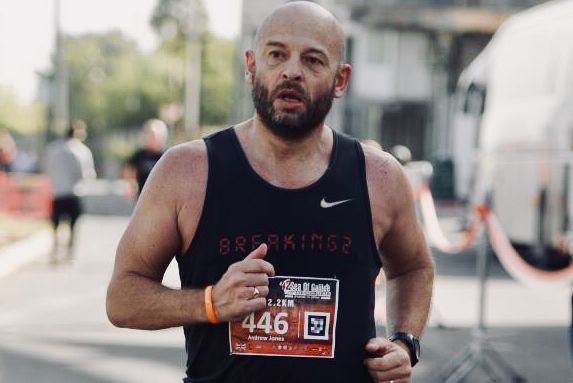Andrew Jones, Ph.D., knows the science behind the marathon, but he hadn’t put his own theories to practice until now.
Andrew Jones, Ph.D., a professor at the University of Exeter in England, ranks among the world’s top running physiologists. For many years, he tested and advised Paula Radcliffe, who would eventually set the current women’s marathon world record, 2:15:25, in London in 2003. Jones’s 2006 paper on their collaboration, “The Physiology of the World Record Holder for the Women’s Marathon,” remains one of the deepest, most remarkable articles in the scientific literature on running.
A decade later, Nike called on Jones to test and select three runners for its Breaking2 project. That effort produced the fastest-known (unofficial) marathon time, 2:00:25, ran by Eliud Kipchoge on a controlled track setting in Italy in May 2017. Last September at the Berlin Marathon, Kipchoge lowered the official world marathon record to 2:01:39, holding an average mile pace of 4:38 for 26.2 miles.
For his part, Jones, born in Wales, was a talented runner in his time, though he excelled in much shorter distances than the athletes he would one day advise. In 1987, when he was 17, Jones set the still-standing U.K. under-18 half marathon record, running a 1:06:55 in the English town of Stroud. But he soon decided to focus on science rather than running and racing, accepting fellowships at the American College of Sports Medicine, British Association of Sport and Exercise Sciences, and the European College of Sport Science, as well as editing the European Journal of Sport Science.
Ultimately, Jones became a marathon expert without ever having run one himself.
That is, until earlier this month. On January 4, Jones, now 48, finished the Tiberias Sea of Galilee Marathon in 3:34. Here, the physiologist shares his race experience, discusses what he has absorbed from his many years working with Radcliffe and Kipchoge, and predicts what’s next for the science of endurance excellence.
Runner’s World: Why did you decide to run a marathon now?
Andrew Jones: I’d been thinking about the marathon for some time, as it was the only standard distance I had never raced. I hoped to run one in Amsterdam in 2017 and Paris in 2018, but injuries interrupted both efforts. I was thinner and fitter for those two races—I ran a 1:26 half in October, 2017—but this time I decided to focus on staying healthy through training, even if I didn’t get as fit.
How did you train?
I basically ran every other day. This helped me train continuously for 12 weeks at about 30 to 35 miles a week. My schedule was something like this: Five to seven miles steady on Tuesday, seven to nine miles with speed intervals of 20 x 1 minute on Thursday, three miles easy on Saturday, and a long run of 13 to 22 miles on Sunday. While running was my only aerobic exercise (I’ve never enjoyed swimming or cycling), I supplemented my runs with strength training.
[Blast through a series of HIIT sessions to boost running strength and prevent injury with the IronStrength Workout.]
How did the race go?
It was tough! I was busy speaking at a conference beforehand, and as a result, I probably wasn’t as glycogen-loaded and hydrated as I should have been. I figured I would run between 3:20 (best case) and 3:40, and it turned out I was on 3:27 pace until the wall got me at 20 miles. My pace dropped against my will, even when I increased my effort. It took me an extraordinary 15 minutes to cover the last 1.3 miles, and I finished in 3:34:34.
Marathon debut, Sea of Galilee. You’d think I’d know better but I hit the bloody wall at 20 miles and then really struggled but managed 3:34 pic.twitter.com/aomRzpg8W9
— Andrew Jones (@AndyBeetroot) January 4, 2019
What will you do differently next time?
I learned that the marathon is very different from shorter races, because if things go bad, you might still have a lot of miles ahead of you. Nutrition, hydration, weather, pacing, patience, and psychology have a big impact. The Tiberias Marathon didn’t provide sports drinks the first half, which wasn’t ideal, especially since it was a bit warm outside. I caught and passed the 3:30 pace group halfway in, because my pace felt comfortable at the time—but that was a mistake. I should have stuck with them. If I run another marathon, I’ll do even more long runs in training, and I’ll practice drinking while running outdoors.
There’s a lot of debate about fats versus carbs for endurance performance. Where do you stand? Does it make a difference if someone is running a 5:00 or 2:00 marathon?
Carbohydrates are really important in all distances, including the marathon. It costs less oxygen to generate energy from carbohydrates compared to fats. I would not contemplate a high-fat diet. However, being able to use both fats and carbohydrates efficiently is useful for ultra-endurance, multi-day events and perhaps very slow marathons.
For his part, Jones, born in Wales, was a talented runner in his time, though he excelled in much shorter distances than the athletes he would one day advise. In 1987, when he was 17, Jones set the still-standing U.K. under-18 half marathon record, running a 1:06:55 in the English town of Stroud. But he soon decided to focus on science rather than running and racing, accepting fellowships at the American College of Sports Medicine, British Association of Sport and Exercise Sciences, and the European College of Sport Science, as well as editing the European Journal of Sport Science.
Ultimately, Jones became a marathon expert without ever having run one himself.
That is, until earlier this month. On January 4, Jones, now 48, finished the Tiberias Sea of Galilee Marathon in 3:34. Here, the physiologist shares his race experience, discusses what he has absorbed from his many years working with Radcliffe and Kipchoge, and predicts what’s next for the science of endurance excellence.
Runner’s World: Why did you decide to run a marathon now?
Andrew Jones: I’d been thinking about the marathon for some time, as it was the only standard distance I had never raced. I hoped to run one in Amsterdam in 2017 and Paris in 2018, but injuries interrupted both efforts. I was thinner and fitter for those two races—I ran a 1:26 half in October, 2017—but this time I decided to focus on staying healthy through training, even if I didn’t get as fit.
How did you train?
I basically ran every other day. This helped me train continuously for 12 weeks at about 30 to 35 miles a week. My schedule was something like this: Five to seven miles steady on Tuesday, seven to nine miles with speed intervals of 20 x 1 minute on Thursday, three miles easy on Saturday, and a long run of 13 to 22 miles on Sunday. While running was my only aerobic exercise (I’ve never enjoyed swimming or cycling), I supplemented my runs with strength training.
[Blast through a series of HIIT sessions to boost running strength and prevent injury with the IronStrength Workout.]
How did the race go?
It was tough! I was busy speaking at a conference beforehand, and as a result, I probably wasn’t as glycogen-loaded and hydrated as I should have been. I figured I would run between 3:20 (best case) and 3:40, and it turned out I was on 3:27 pace until the wall got me at 20 miles. My pace dropped against my will, even when I increased my effort. It took me an extraordinary 15 minutes to cover the last 1.3 miles, and I finished in 3:34:34.
What will you do differently next time?
I learned that the marathon is very different from shorter races, because if things go bad, you might still have a lot of miles ahead of you. Nutrition, hydration, weather, pacing, patience, and psychology have a big impact. The Tiberias Marathon didn’t provide sports drinks the first half, which wasn’t ideal, especially since it was a bit warm outside. I caught and passed the 3:30 pace group halfway in, because my pace felt comfortable at the time—but that was a mistake. I should have stuck with them. If I run another marathon, I’ll do even more long runs in training, and I’ll practice drinking while running outdoors.
There’s a lot of debate about fats versus carbs for endurance performance. Where do you stand? Does it make a difference if someone is running a 5:00 or 2:00 marathon?
Carbohydrates are really important in all distances, including the marathon. It costs less oxygen to generate energy from carbohydrates compared to fats. I would not contemplate a high-fat diet. However, being able to use both fats and carbohydrates efficiently is useful for ultra-endurance, multi-day events and perhaps very slow marathons.
Runners can create some positive physiological adaptations by occasionally restricting carbohydrates in training. For example, you can run first thing in the morning before breakfast. But it isn’t a good idea to restrict carbohydrates before or during a marathon.
How are Paula Radcliffe and Eliud Kipchoge different from 99.99 percent of runners?
Obviously they are blessed with incredible physiology in terms of VO2 max, running economy, lactate threshold, and body dimensions. Paula and Eliud also know how and when to train and race very hard, and when to back off.
They also have an unshakeable belief in themselves and never set limits on what they could accomplish. They’ve gotten to where they are by staying patient with themselves, training consistently and progressively for many years, and taking a long-term view on their careers.
How will the next generation of marathoners get faster?
You never know who might emerge in the future (especially from East Africa), and the next generation will have new targets to chase. But, as with track events, faster marathons will be linked to technological developments. For example, big-city marathon courses are not ideal for fast times, and so special events such as the Nike Breaking2 race are probably what’s required for new records.
When will the 2-hour-marathon barrier fall?
Sooner than most people think. I’ll say five to 10 years, but it depends on how soon (or if) someone else with Kipchoge’s talent comes along.

































[…] 由 Yiu Kwong Chan – 2019-01-29 .fb_iframe_widget span{width:460px!important}.fb_iframe_widget iframe{margin:0!important}.fb_edge_comment_widget{display:none!important}圖片來源 […]